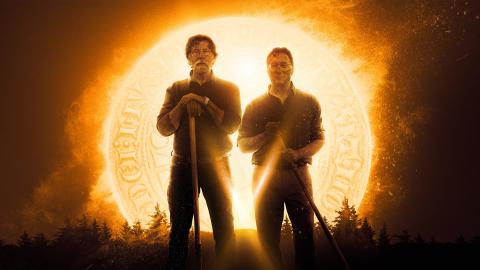Luciferians: satanic sects and the Knights Templar
The new season of Knightfall sees battle-hardened Templar, Landry du Lauzon, face his most gruelling challenges yet. Having been disgraced and demoted, he’s faced the wrath of the Templar equivalent of a drill sergeant (played by a grizzled Mark Hamill) and has to come to blows with the Luciferians, a lethal Satanic sect.
But did the Luciferians really exist? Answering that means probing the strange and half-forgotten world of heretics and renegade Christians in medieval Europe, and the dark rumours that swirled around them. As it turns out, the shadowy sect known as the Luciferians may, like many other marginalized groups, have owed a lot of their thinking to ancient Gnostic thinkers, whose views were regarded as dangerous and borderline Satanic by early Christians.
Take the furious words of the 4th Century bishop Epiphanius of Salamis, who described a group of Gnostics as 'a blasphemous assembly”, and raged at how “the filthy perversity of their beggarly obscenity truly pollutes the ears'.
So, who were these heathens? Rising in the first, second and third centuries AD, the Gnostics were a diverse range of groups and movements which believed in radically different versions of familiar Biblical stories. Some believed, for example, that the God of the Old Testament and the God of the New Testament are NOT one and the same. According to a Gnostic school of thought, the God of the Old Testament is in fact a lesser, malicious being, known as the Demiurge, who trapped humanity in the material realm, which is inherently corrupt.
Just as shockingly, some Gnostics believed that Judas Iscariot, far from being the loathsome traitor who sold Jesus out for 30 pieces of silver, was actually the most important and faithful disciple, who was instructed to 'betray' his mentor so that Jesus could be liberated from the prison of his physical, material form. Yet another radical Gnostic view was that Christ never existed in a physical form at all, and was a kind of phantom or apparition on Earth (an idea known as Docetism).
It’s no wonder that, when Gnostic ideas crept up again in the Middle Ages, those daring to believe in such things were putting themselves in serious danger. The new era of religious persecution in Europe began in 1022, centuries before the formation of the Spanish Inquisition, when members of a heretical sect were tried and burnt at the stake in Orleans, France. The heretics allegedly had Gnostic-like beliefs about the corruption of the material world, while one contemporary chronicler, Ademar de Chabannes, described how the Devil himself appeared to the heretics, 'on one occasion in the guise of an Ethiopian and on another as an angel of light… In obedience to him they secretly rejected Christ, and in private committed sins and crimes which it would be sinful even to mention'.
Kill them all. God will know his own
While the specific beliefs of the Orleans heretics have been lost in time, a sect emerged in 10th Century Bulgaria who certainly brought back the old Gnostic beliefs. They were the Bogomils, who condemned the material world as corrupt and rejected many teachings of the Orthodox Church. Another group of neo-Gnostics who gained considerable fame (and infamy) were the Cathars of France. They believed the New Testament God was good and the Old Testament God was wicked – some even equated the Old Testament God with Satan himself. Their loathing of the sin-infused material world was so extreme that they regarded reproduction as inherently immoral.
The Cathars’ radical rejection of the Catholic Church led to their brutal persecution. An entire crusade was launched by the Pope against them in the 13th Century. In Knightfall de Nogaret's Cathar parents were burned at the stake for their heresy. This savage crusade has since been regarded as an act of genocide against the Cathars. During the siege of the Cathar town of Beziers, crusaders asked the abbot of Cîteaux how to tell 'good' Catholics from the wicked Cathars. To which the abbot replied: 'Kill them all. God will know his own.'
But what about those Luciferians? References to such a group were recorded in Europe in the 13th and 14th Centuries, with a certain 'Lucardis' being named as the woman who led the sect. According to a chronicle, this Lucardis wanted to restore Lucifer to his righteous place in Heaven.
The rumours of such dark practices were certainly taken seriously by Pope Gregory IX, who issued a papal bull describing the Satanic ceremonies in colourful terms. It describes how Luciferian initiates have to kiss a toad, 'in a damnable way receiving the tongue and the saliva of the beast in their mouth', before worshipping a black cat and commencing a rampant orgy, featuring incest and gay sex ('the men, swept with ignoble passions and the unquenchable fire of their desires, perform their shameful acts in men, in the same way as they would make natural use of them when they would have been women').
Interestingly, the propaganda churned out by the Catholic Church against these alleged Satanists mirrored the diatribes against the Cathars and other sects that dared defy the mainstream religion. It seems that the Luciferians were, in actual fact, another neo-Gnostic off-shoot, who had adopted the old belief about the Demiurge being the true, malevolent creator of the world, but chose to worship this Demiurge instead of condemning him. In the words of historian Jeffrey Burton Russell, this was in effect a 'heresy of a heresy'. What became of the Luciferians and how many might have been killed for their heresies, remains a mystery of history.
















